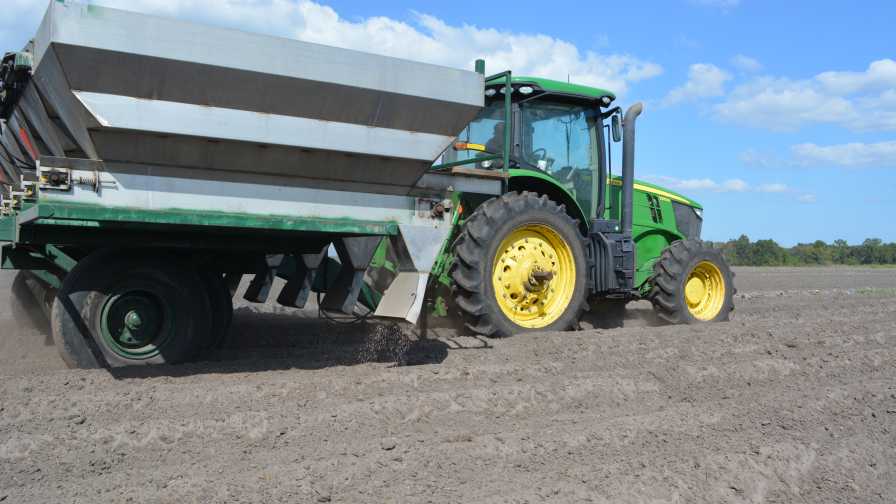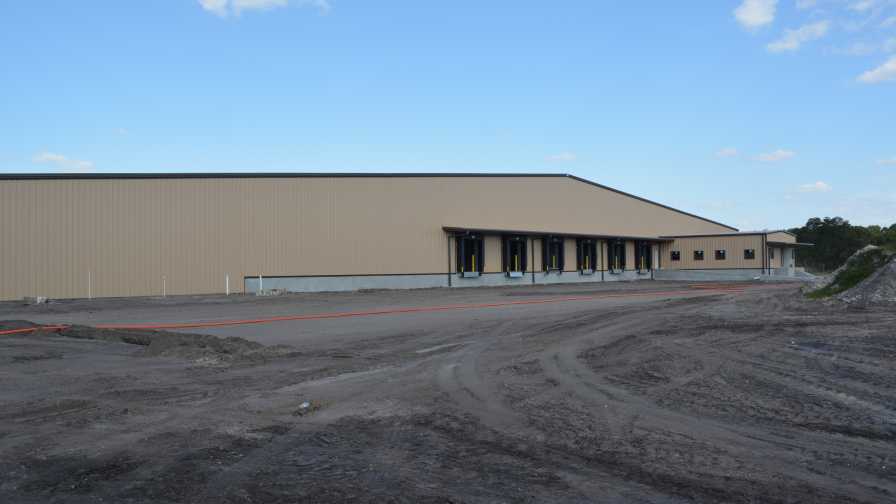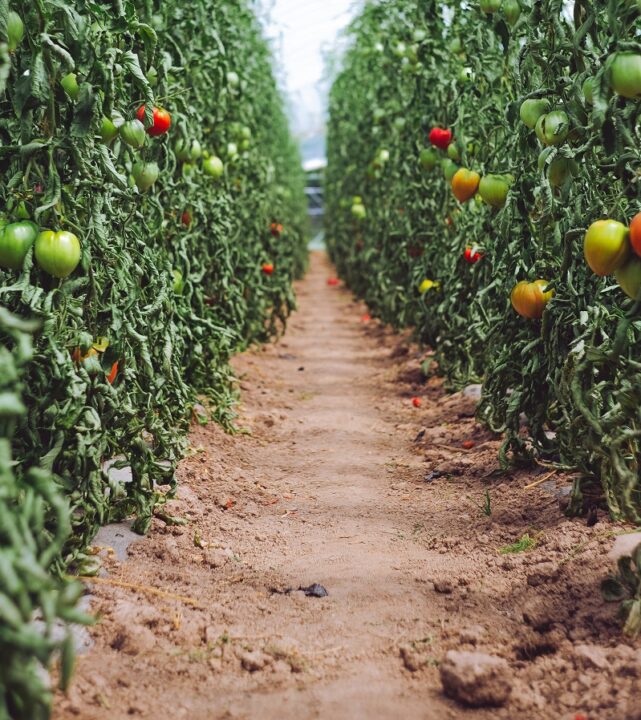Protecting Agriculture’s Future A Win-Win For Florida Farmer

Alan Jones and his operation Jones Potato Farm in Parrish, FL, is among winners of the 2016 Florida Commissioner of Agriculture’s Ag Environmental Leadership Award.
Photo by Frank Giles
Alan Jones has seen and learned a lot in his 30-plus years of farming. He has learned that being committed to the profession of agriculture and serving your local community and the nation involves being open to change and embracing new practices.
“In 1987, my father and I moved to Manatee County and started farming potatoes,” Jones says. “At the time, I was studying agriculture at the University of Florida. I was going school, then coming home to Parrish to farm in the spring.
“In 1991, I moved to Manatee County and started farming full time. Coming out of school with a strong ag background, I felt like I had it all figured out, but I really didn’t have a clue. So, I reflect on these 30 years and appreciate all the things I have learned.”
When his father sold the operation to his son, Parrish-based Jones Potato Farm covered 450 acres. Today, Jones and his wife Leslie manage 4,000 acres of potatoes, green beans, and citrus, along with cattle. The newest addition to the business is a vegetable packing facility that should be in operation this season. Jones, V.L. Walker, and L&M Produce will utilize the packinghouse to facilitate Florida operations.
“My dad gave me a great opportunity to learn and enough rope to grow the farm or not,” he says.
Jones says a big part of his learning about new farming methods involved environmental concerns. He took these issues to heart and has implemented a number of practices over the years that have improved efficiency of operations and have provided positive impacts on the environment. For this reason, Jones Potato Farm was a winner of the 2016 Commissioner of Agriculture’s Ag Environmental Leadership Award.
“Over the years, I became familiar with terms like red tide and carbon footprint, and I then reached out to the water management districts, FDACS, and the Florida Department of Environmental Protection to address these concerns,” he says. “We are out in the fields every day and we get caught up in growing a crop and making a living. It is important to step back and appreciate our role as leaders when it comes to the environment, food safety, and feeding the nation. As growers, we need to be leaders in all these areas.”
Priority On Soil Heath
A concept that has risen in importance in recent years is maintaining and improving soil health. Jones says this is something that has been a focus on his farm since the beginning.
“There is a saying that your trail forward is guided by the trail you leave behind,” he says. “I think if you leave a path of sustainably behind, there will be a positive path forward.”
To maintain soil health, Jones plants a sorghum/cowpea mix cover crop to help reduce wind and water soil erosion between crops. The crop is tilled in before planting potatoes or green beans. The cover crop has helped build organic matter in the soils over the years and keeps weeds in check.
“We also plant green beans as a rotational crop,” Jones says. “The beans marry up well with the potatoes and also leave us a little residual nitrogen that benefit the potatoes.”
Jones follows BMPs in his potato, citrus, and green bean crops. In 2013, Jones was awarded the 4R Nutrient Stewardship Program Advocate Award. He is the first Florida grower to win the national recognition.
He has worked closely with FDACS to not only implement BMPs, but also find new opportunities for the program. He is currently working with the agency to develop a BMP for the use of reclaimed water on his grove in LaBelle.

Alan Jones employs numerous BMPs on his farm, including banding dry fertilizer to fields.
Photo by Frank Giles
Precisely Efficient
One of the core principles of sustainability is efficiency in all crop inputs and applications — putting the right inputs in the right place in the right amounts. In the past two years, Jones has adopted precision agriculture practices to increase efficiency even more by working with Dennis Coleman of Crop Production Services.
He began his precision program by intensively soil testing fields and creating maps based on fertility, pH, cation exchange capacity (CEC) readings, and more. For example, there were 24 samples taken on one 51-acre field on Jones’ farm.
“In that field, our CEC ranges from 3 to 10.2,” Jones says. “We are monitoring pH, calcium, magnesium, and general fertility. Does every acre of that field need the same amount of nutrient inputs? No.”
Based off the soil map, Jones then has nutrients applied with variable rate equipment controlled by GreenStar. The variable rates are applied to the third fertilizer application. The first two applications follow standard rates.
“We give the spreader truck driver a thumb drive with map information,” Jones says. “He plugs it in and drives. On that 51-acre field, for example, we will be applying dolomite lime anywhere from 3,000 pounds per acre to 900 pounds per acre based off the soil map. We are putting exactly what we need where we need it.”
Jones says the final piece of the precision ag puzzle will be adding yield monitors to the farm. He will be working with FDACS to see if a cost-share opportunity will be available for the yield monitors.
“When we can lay the yield monitor maps on top of the fertility maps, we will get an even better understanding of what we are doing in terms precision agriculture,” he says. “It might be five to 10 years down the road before we get the full benefit of all this information. But to make good decisions, you need the right information.”

Low-volume center pivot irrigation saves more than one million gallons of water daily on Jones Potato Farm.
Photo courtesy of Jones Potato Farm
Maximizing Water
Water availability and quality has grown into a tremendous issue in Florida and will rise even more if population projections hold true. A study by the Bureau of Economic and Business Research puts the state’s population at more than 24 million by 2030.
State agencies are encouraging water conservation efforts to ensure a stable water supply as newcomers move in. Jones has worked closely with the Southwest Florida Water Management District (SWFWMD) to install water-saving equipment on his farm through its Facilitating Agricultural Resource Management Systems (FARMS) cost-share program.
He had observed the tremendous water savings low-volume center pivot irrigation systems were affording growers in other parts of the country, so he approached SWFWMD about a cost-share to install a system on his farm. At the time, the agency had no data on water savings with the systems and there was no cost-share opportunity. So, Jones installed a center pivot on the farm in 2011 to establish how much water could be conserved with the system.
“We put in the center pivot and started collecting data,” Jones says. “In the first year, we saw a 70% savings of water. I put that data in front of the District and was able to get a cost-share to move forward with the installation of more pivots.”
The next year, Jones installed 15 more center pivots across the farm with the help of the FARMS program. It remains the largest FARMS project in the state to date. He says pivots do not save 70% of water every year, but consistently conserve more than 50% of historical usage, which equates to more than a million gallons per day on his farm.
Jones says the irrigation approach is not a one-size fits all. While there are tremendous water savings with the pivots, there are still dry pockets in fields.
“We have adapted the system to include a semi-closed system in conjunction with the closed system to maintain a base soil moisture in fields,” he says. “We do this with furrow ditch irrigation as well as the pivots. So, the crops are getting moisture from below and above to maintain optimum field capacity.”
Jones uses an old, but effective, method to measure field capacity with float wells. The wells visually show where the water table is in spots across the field. Floating PVC pipe painted green marks the sweet spot for field moisture.
“It is a rudimentary soil moisture probe, but I can drive by a field at 40 mph and know exactly where I am at in terms of irrigation needs. It is amazing to watch how much it [float well] moves even with small rain events.”

A new, state-of-the-art packing facility is being added to Jones Potato Farm.
Photo by Frank Giles
Community Outreach
Jones believes the definition of sustainable agriculture also includes involvement in the local community to educate consumers about the healthy, local produce being grown in their own communities. And in addition, to illustrate that it can be done in an environmentally sound way.
The farm has been involved with the FDACS Farm-To-School program since its inception and has used social media and the company website as tools for public education. Jones also has been active in local government planning for the future. He is a board member of the Manatee County Economic Development Council.
“The city is moving closer to the farm every day,” he says. “We have to take a proactive role in representing our industry not only from an agricultural standpoint, but also from a development standpoint. Land rights are key components of every ag operation.”










